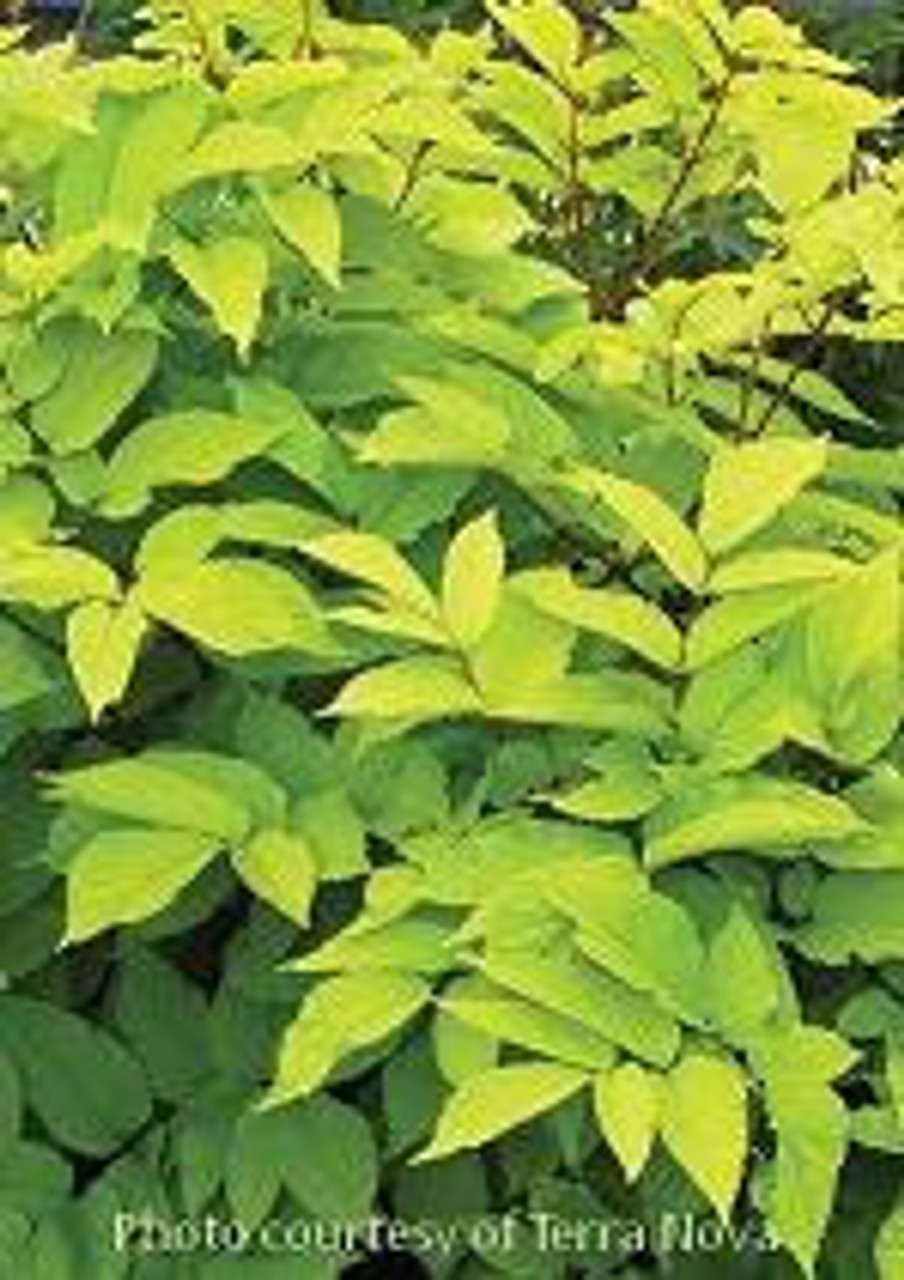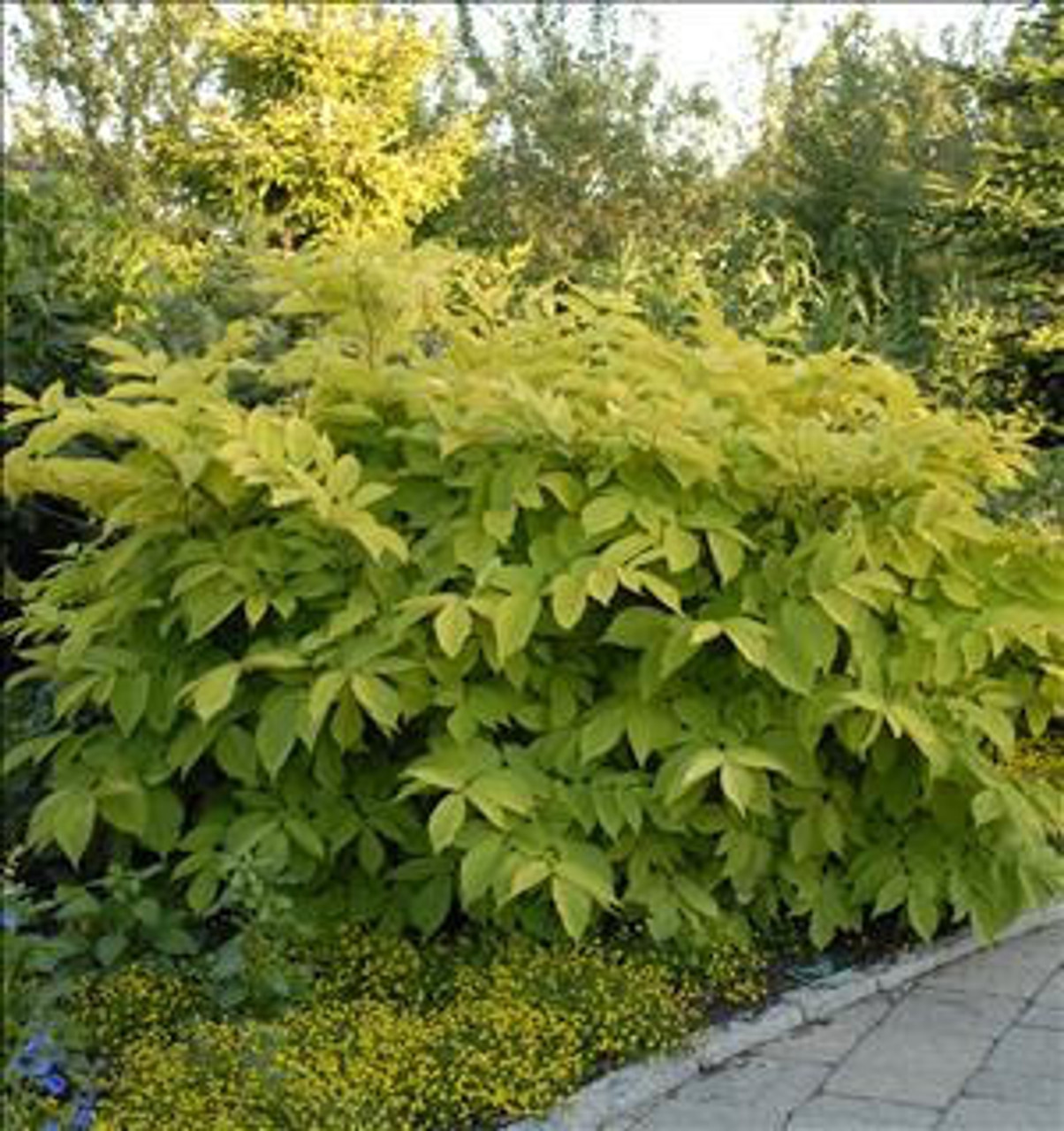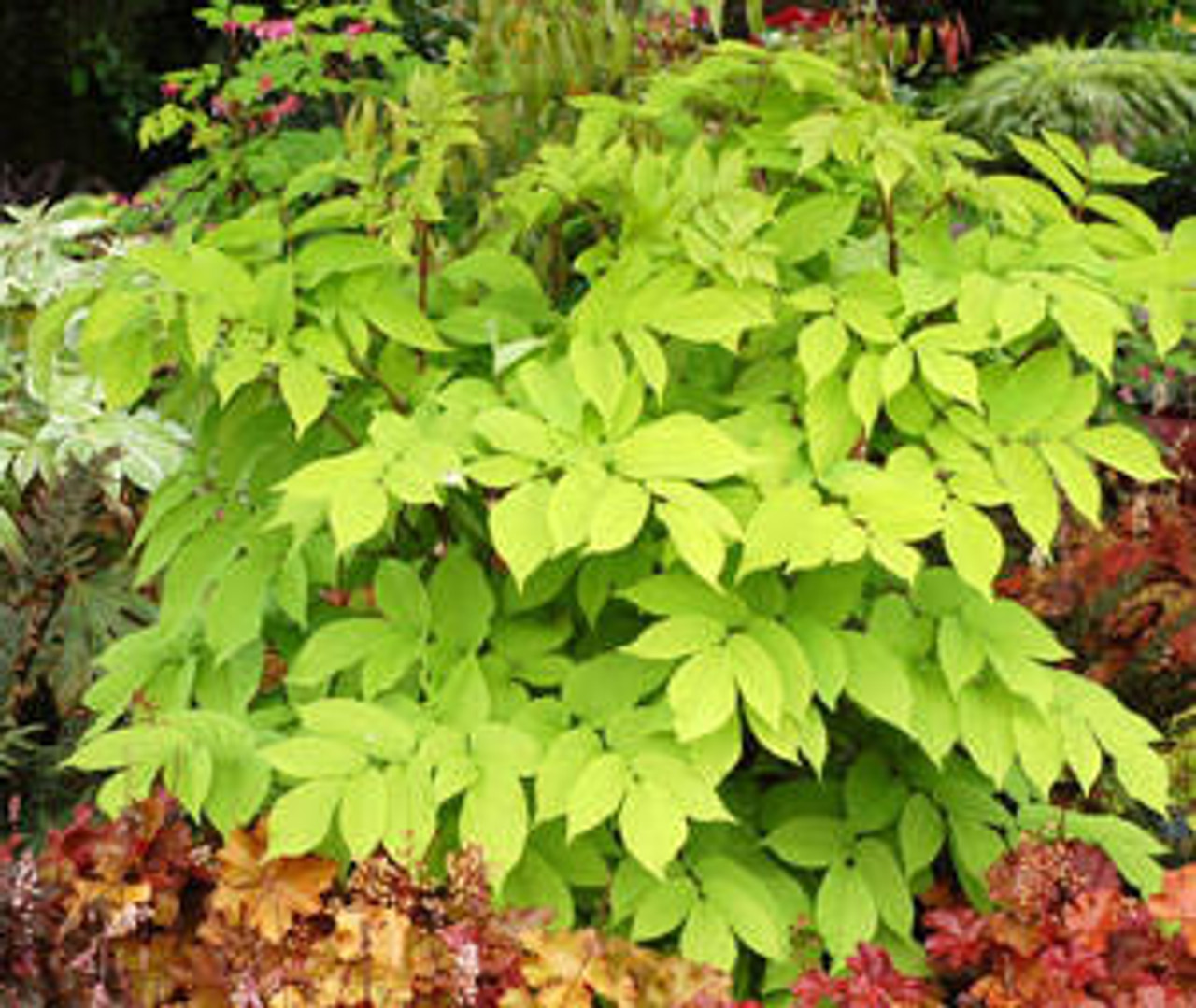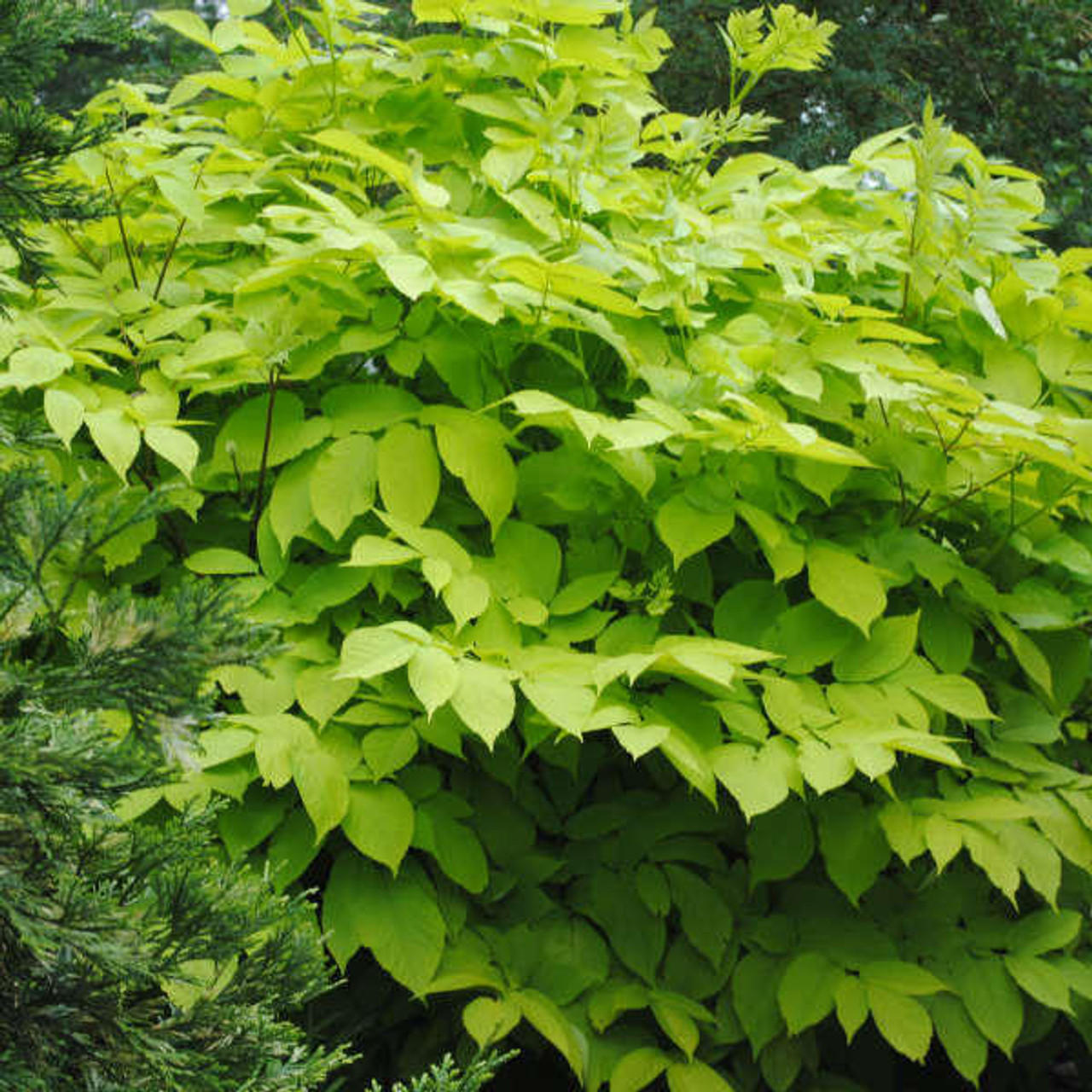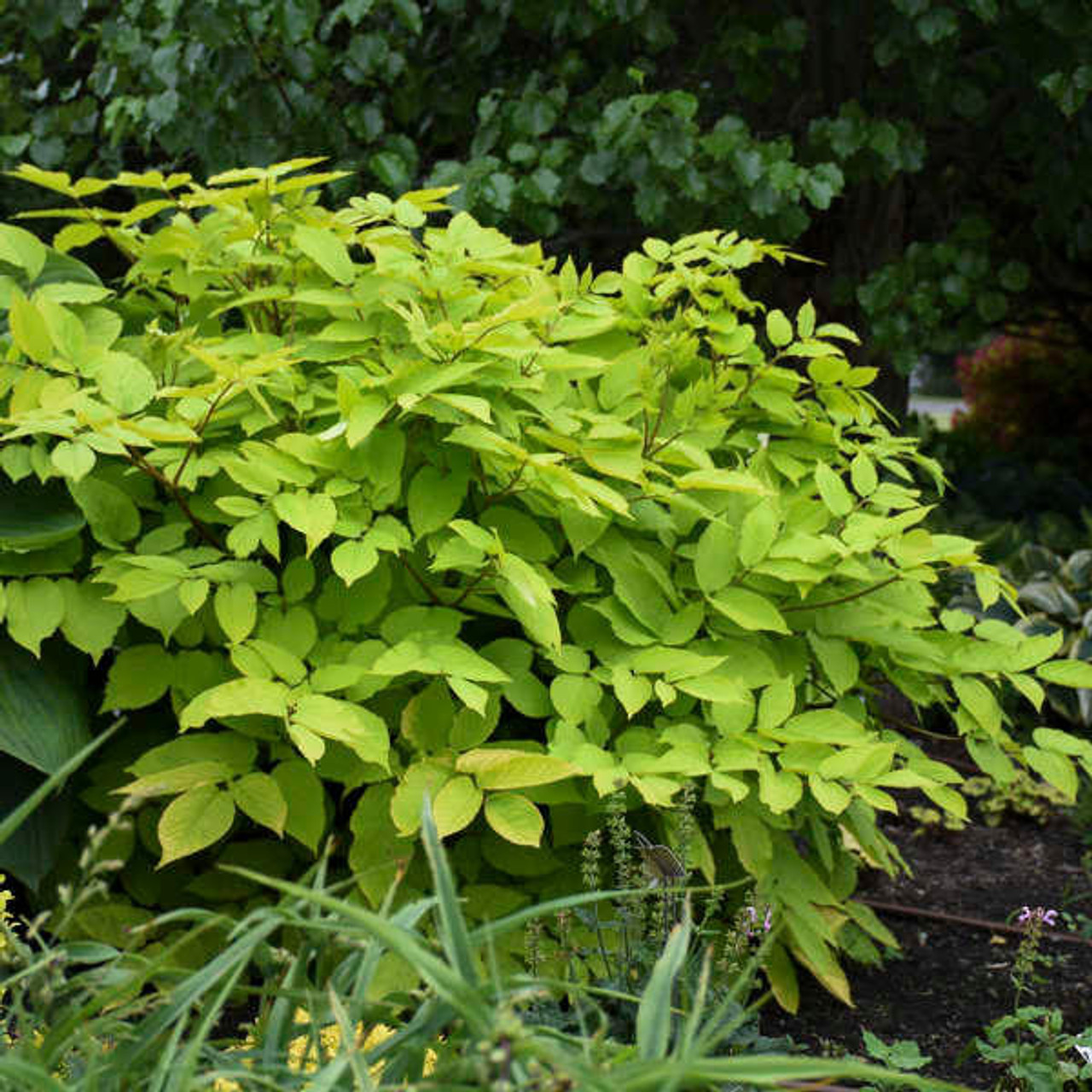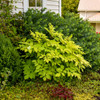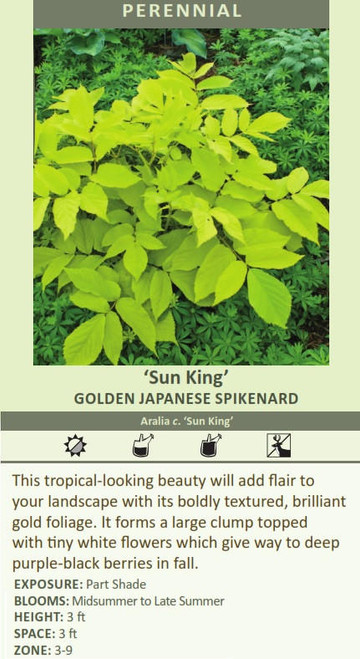Product Description
Aralia cordata 'Sun King '
Common Name: Golden Japanese Spikenard.
2020 Perennial Plant of the Year
'Sun King ' emerges mid-spring with bright gold leaves on contrasting reddish brown stems. With at least a few hours of sun a day, the foliage will remain yellow all summer. In heavier shade, the foliage ranges from chartreuse to lime green. In mid to late summer, interesting racemes of tiny white flowers are produced followed by deep purplish black, inedible berries.
An excellent tropical-looking complement to Hostas and woodland perennials, the flowers attract honeybees. Herbaceous perennial quickly forms a large clump of foliage. It typically grows three feet tall and wide, though many reported it will grow larger over time.
This unique perennial grows best in part to light shade, though if given consistent moisture it can also grow in full sun. It prefers richly organic, deep loamy soil that is moist but well-drained. This plant is not drought tolerant. It typically dies back to the ground in winter and re-emerges in spring to quickly form a shrub-like clump.
Resists deer browsing!
- Remains yellow in part shade; chartreuse to lime green in heavy shade
- Tiny white flowers give way to purple-black berries in fall
Height: 3.0 Feet
Spread: 3.0 Feet
Hardiness Zones: 3,4,5,6,7,8,9
Flower Color: White Shades
Foliage Color: Green shades, Yellow shades
Part Shade (4-6 hrs. Direct Sun)
Average to Consistent Water Needs
Average to Fertile Soil Quality
Bloomtime: Midsummer - Late Summer
Deer and Rabbit Resistant
Growth Rate: Medium to Rapid
Border Plant, Attractive Foliage, Specimen, Focal Point
Aralia c. 'Sun King', also known as Japanese spikenard , is a herbaceous perennial with vibrant golden-yellow foliage . It was named the 2020 Perennial Plant of the Year and is a popular choice for adding a touch of brightness to shady gardens. This article will explore the characteristics, growing conditions, care, and potential uses of this remarkable plant.
Aralia c. 'Sun King' is native to Japan and typically grows to a height of 3-6 feet, with some reaching up to 6 feet tall and 4 feet wide . It has a lifespan of approximately 20 years . This plant is also known for being deer-resistant . One of its most notable features is its wonderfully bold, coarse texture, which can be very effective in a balanced garden composition . It typically dies back to the ground in winter and re-emerges in spring to quickly form a shrub-like clump.
Foliage The large, impressive compound leaves of Aralia c. 'Sun King' emerge lemon yellow in spring and turn gold throughout the season . The leaves are held on reddish-brown stems, creating a striking contrast . The color will be brighter yellow in part sun, and more chartreuse or lime green in full shade.
Flowers In mid to late summer, the plant produces airy racemes of tiny white flowers . These flowers attract honeybees, adding to the plant's value in a pollinator garden.
Berries Following the flowers, deep purple-black berries appear in the fall . These berries are inedible but provide a source of food for birds.
Growing Conditions Aralia c. 'Sun King' thrives in partial shade to full shade . While it can tolerate some sun, especially in cooler climates, its foliage color is often most vibrant with some protection from harsh midday sun . It performs well in both full sun and full shade, as long as it receives consistent moisture . The plant prefers moist, well-drained soil rich in organic matter and needs consistent moisture to thrive . It is not drought tolerant . This plant is highly tolerant of urban pollution and will even thrive in inner-city environments . For optimal growth, it's best to site it in locations protected from strong winds to protect the foliage . It is hardy in USDA zones 4 to 8.
Care and Maintenance Aralia c. 'Sun King' is a low-maintenance plant . However, some care is still required to ensure its healthy growth.
- Pruning While no regular pruning is required , it is best to cut back the plant to the ground in late winter before active growth resumes . This helps to maintain a tidy appearance and encourages fresh new growth . You can also remove any dead or damaged stems in spring . Gardeners should be aware of the plant's suckering characteristic.
- Fertilizing Aralia c. 'Sun King' is not a heavy feeder. Amending the soil with compost or aged manure before planting is beneficial . A light application of balanced, slow-release fertilizer in spring is usually sufficient.
- Pest Control Aralia c. 'Sun King' is generally pest and disease resistant . However, it may occasionally be affected by aphids, mealybugs, spider mites, slugs, and snails . Leaf spot may also appear . Monitor the plant regularly and address any issues promptly.
- Propagation Aralia c. 'Sun King' can be propagated by seed or by division in spring . Aralias often self-sow where the berries drop and are somewhat easy to naturalize into colonies.
Potential Uses Aralia c. 'Sun King' is a versatile plant with various uses in the garden:
- Brightening Shady Areas: Its golden foliage makes it an excellent choice for illuminating dark corners of the garden.
- Woodland Gardens: It blends beautifully with other shade-loving plants in a woodland setting, such as ferns and hostas.
- Specimen Plant: Its large size and striking foliage make it a standout specimen plant.
- Background Planting: It can be used as a backdrop for other perennials in a mixed border.
- Mass Planting: When planted in masses, it creates a bold and dramatic effect.
- Container Gardens: It can be grown in large containers to add a bold statement to patios or decks.
- Naturalizing and Woodland Gardens: This plant is well-suited for naturalizing and woodland gardens due to its ability to spread and form colonies.
Other Uses Young shoots of this plant are considered a culinary delicacy in Japan, where they are cultivated in underground tunnels. They have a taste resembling that of asparagus.
Aralia c. 'Sun King' is a remarkable plant that offers a unique combination of beauty, versatility, and low maintenance. Its vibrant golden foliage, attractive flowers, adaptability to both full sun and shade with consistent moisture, and tolerance to urban pollution make it a valuable addition to any garden. Whether used as a specimen plant, in mass plantings, or as part of a mixed border, Aralia c. 'Sun King' is sure to brighten up any shady spot and attract pollinators like honeybees and birds. Its bold texture and striking foliage make it an excellent choice for adding visual interest to a garden composition. With its ease of care and long lifespan, Aralia c. 'Sun King' is a rewarding plant that will provide years of enjoyment in the garden.
Other Details
The most important part of the plant is its root system. Healthy roots are the foundation of a healthy, vibrant plant. The type of plug container used is based on the specific needs of the plants. Perennials offered as bare root traditionally perform better when planted as bare root.Planted in a specialized mix, potted plants have well established root systems. Top growth stage will vary depending on the current life cycle and time of year when shipped. In Winter and early Spring dormant plants may be shipped. Dormant plants may be planted right away, even before the last frost date.
Most bare root varieties are field grown for at least one season, though Hemerocallis and Hosta are grown for two seasons. The bulk of the soil is removed during the harvesting process and the tops of most varieties are trimmed back to the crown. They are graded, packed in shredded aspen or sphagnum moss and stored in freezers until ready to be shipped.
See our Container Sizes and Bare Root Perennials pages for more information.
Plant information and care is provided in the Overview section, Plant Genus Page and general information is provided in the Planting Care & Guides. Additional questions can be asked on each Plant page.
Plant Spacing: Using the maximum mature spread or width of a plant to guide spacing, ensures space to grow to full size. To fill an area sooner, plant them closer together. Just remember, future thinning or transplanting may be needed.
Water: Keep a close eye on newly planted perennials, especially throughout the first growing year. Most early plant loss is due to too much or too little water!


